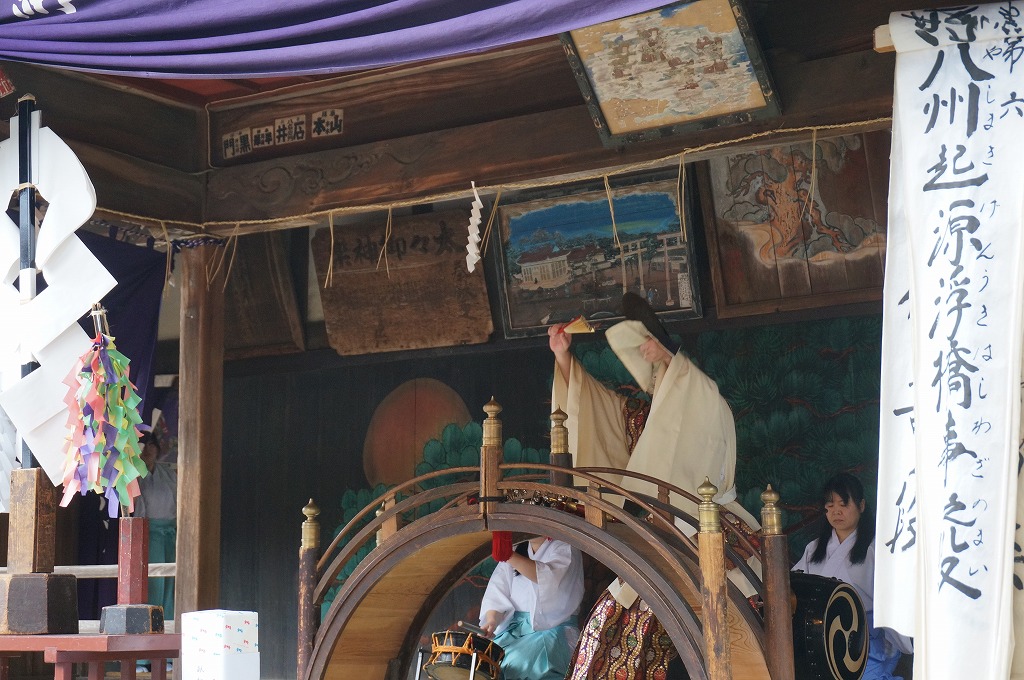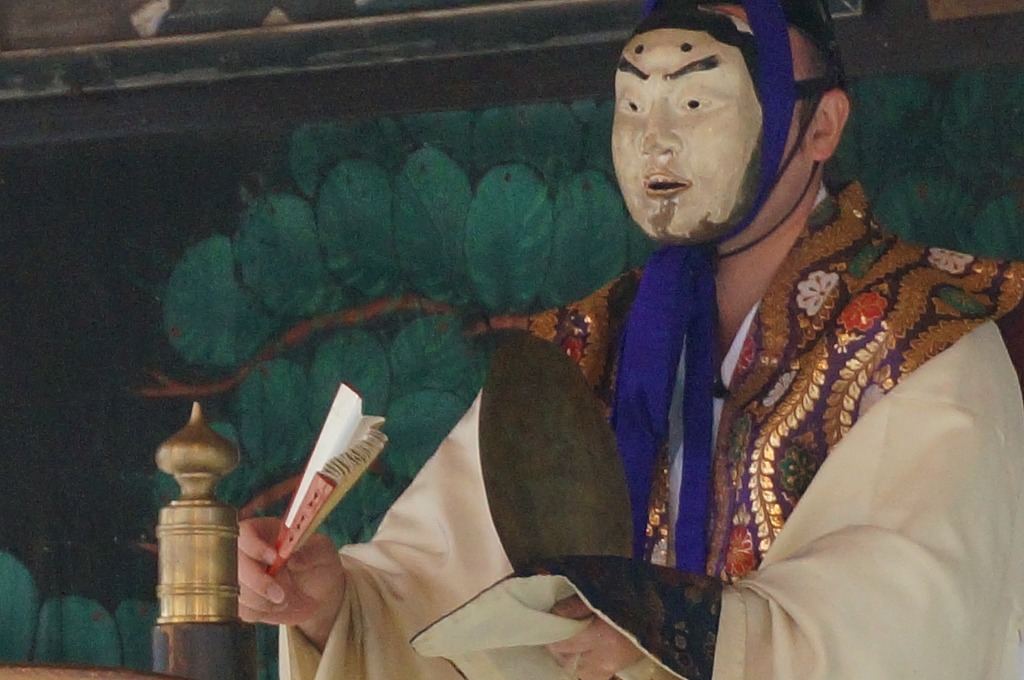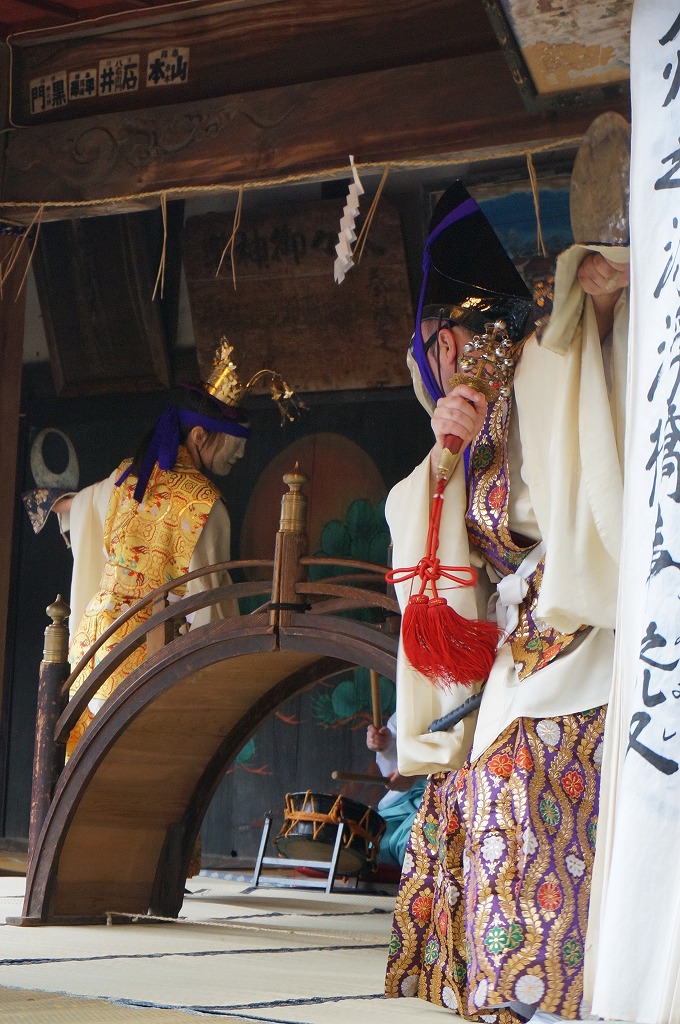Report: 1/35 of the most important of the folk performing art Haji Ichiryu Saibara Kagura 土師一流催馬楽神楽
Date: 1st January, 14th February, 10th April, 10th October, and day of “Tori” in December, every year
Location: Washinomiya shrine Washinomiya, Kuki city, Saitama prefecture
How to get there: It takes 10 minutes from Washinomiya station (Tobu Isezaki line)
※This kagura is consisted of 12 programs.
※This kagura is one of 35 an important Intangible Folk Cultural Heritage by Japanese national government.

Introduction
This kagura is called “the source of Kanto kagura” (Kanto is located in center of Honshu which is main island of Japan, and is the generic name of seven prefectures). In addition, this is one of the country designation important intangible cultural asset which there is 35.
”Sada shinno” originally started in Shimane prefecture. A Shinto priest of Sada shrine learned Noh in Kyoto about the beginning of 17th Century, and made a new kagura (so called Sada Shinno) baced on the Noh style. This kagura is known for a distinctive element. That’s the dancer is holding thing (bell, sacred staff with cut paper (heisoku 幣束), or a sakaki leaf and so on). This style of kagura started to be called “Izumo style ” and spread out in the whole country before long. This shrine is where Izumo style was accepted first. So it is called “the source of Kanto kagura”.
But the first document of the kagura in this shrine was recorded in about the middle of 13th century. We don’t know whether this kagura is the same kagura of today.


I went to Washinomiya shrine on 1st January, 2015.
Kuki city is located in Saitama orefecture, population of about 150,000. It is not very big town. It takes about 1 hour from Tokyo by Ueno-Tokyo lune (JR), changing at Kuki to Tobu line, next station being Washinomiya station.
Washinomiya shrine is about a 10 minute-walk from Washinomiya station. We cross a red bridge on the way to the shrine. It like a cnnection between the sacred place and the regular world.


The shrine became a holy ground of animation films in these days. so we can see many persons who wear costumes of animation characters. We can find a middle-aged man who puts on a blond wig wearing sailor uniform (high school girls style ) and skirt among them. You guess that it is quite a surreal scene. Even if it is not so, this shrine is the core of faith in this area. The number of people that gathered exceeded 400,000 in there days. The shrine is quiet in usual times, but only for three days, it becomes really crowded.
First half
On those days, people make a long lines to pray, I passed by them and ran to the hall (kagura-den) where kagura was being performed.

the kagura was going to start about 10 or 10:30. When I arrived at about 11:00. The kagura had already started. The kagura-den is front of the Hon-den (main hall). So many people were there, but nobody was looking at the kagura. The audience seemed to be no more than 20 persons.
On the stage, there were one masked man and two girls. The mask showed an old man smiling gently. He dance slowly holding a bell and sacred staff with cut paper (heisoku 幣束). This kagura’s feature was in a ceremonial manner with hardly any dramatic representation.




I guessed from the title that this program represented at the famous scene of Japanese mythology, “Amano iwato biraki” (see to “Reference/Japan mythology). In “Amano iwato biraki” all deities are pleased when “Amaterasu” (she is a deity of sun) comes out from where she was hidden in a big door of rock. But, it is difficult to understand such a state only by seeing it. It is significant to appease the Earth in every direction by the swinging the bell. This program took about 30 minutes.

Next program is “Hakagura“. This program is where two girls dance swinging a bell. When this program is played, people sitting on the stage play music “Saibara”.”Saibara” is a popular music in Heian period (9~10 C). When we listen to these music, we don’t feel such elements. The oldest music is called “Gagaku”. I feel this music like “Gagaku”faster in tempo. I don’t know if these music remain completely at the time, but I am filled with deep emotion. I think it worth listening to once at least because you would feel the life of ancient Japanese.




Next program is based on Japanese mythology, too. This mythology says in the beginning of time, two deities, named “Izanagi” and “Izanami” gave birth this country. So, a mobile bridge is set on a stage and two players dance across the bridge. The male deity dances powerfully, the female deity dances with grace.While changing their positions they dance around a stage. This program ended at about half past 12. Then there was an intermission.
Intermission


There were many food stalls in the shrine precinct. After I ate lunch, I found a place where people were being fire using metal barrel. This area was surrounded by a double fence, and some people were direct cuttlefish. I thought it was a good system. Only people who bought, direct dried cuttlefish could enter in front of the fire. I saw quite a lot of people buying cuttlefish.
Second half
Meanwhile the kagura started again at 2 o’clock.
First program, two little girls were dancing hoiding a bell. It was short.

Next program was based on mythology,too. When the grandson of “Amaterasu (a deity of sun)”, “Ninigi” goes down from his country “Amatsu kuni” to this earth, two deities got married with the meditation of “Ninigi”. One is a chaperon of Ninigi, named “Ameno Uzume“, and is a deity who had waited Ninigi’s group and led this coutry to safty, mnamed “Sarutahiko“.





So, two dancers enter the stage. One wore a red face mask with long -high nose, and another wore a female mask. The dancer with the red mask is “Sarutahiko”, and the other is “Ameno Uzume”. Sarutahiko held a pike, and Ameno Uzume held a big staff which red pieace of paper. Two dancers faced each other across the bridge, changing their position like the program of “Izanagi and Izanami”. This kagura basically consists of such dancing.
It ended at 2:20.




After short break, next program started. Three dancers each wore a mask of “okina” (old man) with long mustache and beard. They each held fans, and danced slowly making a circle. It is said that it is to express a prayer for a peace of the world.
After 30 minutes, the whole program for today ended.
If you are interested in old style kagura, I recommended to watch this “Saibara kagura”. You can definitely see a noble and elegant dance program.
For more information
This kagura is held at “Washinomiya shrine (branch shrine)”, 15th April. It is at “Hachiho, Washinomiya town”.